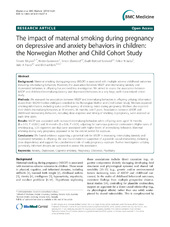| dc.description.abstract | Background: Maternal smoking during pregnancy (MSDP) is associated with multiple adverse childhood outcomes including externalizing behaviors. However, the association between MSDP and internalizing (anxiety and depressive) behaviors in offspring has received less investigation. We aimed to assess the association between MSDP and childhood internalizing (anxiety and depressive) behaviors in a very large, well-characterized cohort study. Methods: We assessed the association between MSDP and internalizing behaviors in offspring utilizing information drawn from 90,040 mother-child pairs enrolled in the Norwegian Mother and Child Cohort Study. Mothers reported smoking information, including status and frequency of smoking, twice during pregnancy. Mothers also reported their child’s internalizing behaviors at 18 months, 36 months, and 5 years. Associations between MSDP and childhood internalizing behaviors, including dose-response and timing of smoking in pregnancy, were assessed at each time point. Results: MSDP was associated with increased internalizing behaviors when offspring were aged 18 months (B = 0.11, P <0.001) and 36 months (B = 0.06, P <0.01), adjusting for numerous potential confounders. Higher rates of smoking (e.g., >20 cigarettes per day) were associated with higher levels of internalizing behaviors. Maternal smoking during early pregnancy appeared to be the critical period for exposure. Conclusions: We found evidence supporting a potential role for MSDP in increasing internalizing (anxiety and depressive) behaviors in offspring. We also found evidence supportive of a possible causal relationship, including dose-dependency and support for a predominant role of early pregnancy exposure. Further investigation utilizing genetically informed designs are warranted to assess this association. | en_US |

